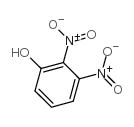2,3-DINITROPHENOL

2,3-DINITROPHENOL structure
|
Common Name | 2,3-DINITROPHENOL | ||
|---|---|---|---|---|
| CAS Number | 66-56-8 | Molecular Weight | 184.10600 | |
| Density | 1.65 g/cm3 | Boiling Point | 328.9ºC at 760 mmHg | |
| Molecular Formula | C6H4N2O5 | Melting Point | 143-146ºC | |
| MSDS | Chinese USA | Flash Point | 151.2ºC | |
| Symbol |



GHS06, GHS08, GHS09 |
Signal Word | Danger | |
|
The Role of Janus Kinase 3 in the Regulation of Na⁺/K⁺ ATPase under Energy Depletion.
Cell Physiol. Biochem. 36 , 727-40, (2015) Janus kinase-3 (JAK3) is activated during energy depletion. Energy-consuming pumps include the Na(+)/K(+)-ATPase. The present study explored whether JAK3 regulates Na(+)/K(+)-ATPase in dendritic cells (DCs).Ouabain (100 µM)-sensitive (Iouabain) and K(+)-induc... |
|
|
Neuroprotective effect of diphenyl diselenide in a experimental stroke model: maintenance of redox system in mitochondria of brain regions.
Neurotox. Res. 26(4) , 317-30, (2014) Acute stroke is a major risk for morbidity and mortality in aging population. Mitochondrion has been the focus of a wide stroke-related research. This study investigated if treatment or pre-treatment with diphenyl diselenide (PhSe)2 can prevent mitochondrial ... |
|
|
Tankyrases regulate glucoregulatory mechanisms and somatic growth via the central melanocortin system in zebrafish larvae.
FASEB J. 29 , 4435-48, (2015) The central melanocortin system is a key regulator of energy homeostasis. Recent studies indicate that tankyrases (TNKSs), which poly(ADP-ribosyl)ate target proteins and direct them toward proteasomal degradation, affect overall metabolism, but the exact mole... |
|
|
Mitochondrial Activity and Cyr1 Are Key Regulators of Ras1 Activation of C. albicans Virulence Pathways.
PLoS Pathog. 11 , e1005133, (2015) Candida albicans is both a major fungal pathogen and a member of the commensal human microflora. The morphological switch from yeast to hyphal growth is associated with disease and many environmental factors are known to influence the yeast-to-hyphae switch. ... |
|
|
Exercise training combined with antioxidant supplementation prevents the antiproliferative activity of their single treatment in prostate cancer through inhibition of redox adaptation.
Free Radic. Biol. Med. 77 , 95-105, (2014) In preclinical models, exercise training (ET) or pomegranate juice (PJ) prevents prostate cancer progression. Here, we hypothesized that physical exercise combined with antioxidants could induce synergistic effects through oxidative stress modulation. Forty m... |
|
|
Air pollution and children: neural and tight junction antibodies and combustion metals, the role of barrier breakdown and brain immunity in neurodegeneration.
J. Alzheimers Dis. 43(3) , 1039-58, (2014) Millions of children are exposed to concentrations of air pollutants, including fine particulate matter (PM2.5), above safety standards. In the Mexico City Metropolitan Area (MCMA) megacity, children show an early brain imbalance in oxidative stress, inflamma... |
|
|
Adenine suppresses IgE-mediated mast cell activation.
Mol. Immunol. 65(2) , 242-9, (2015) Nucleobase adenine is produced by dividing human lymphoblasts mainly from polyamine synthesis and inhibits immunological functions of lymphocytes. We investigated the anti-allergic effect of adenine on IgE-mediated mast cell activation in vitro and passive cu... |
|
|
Transient elevation of glycolysis confers radio-resistance by facilitating DNA repair in cells.
BMC Cancer 15 , 335, (2015) Cancer cells exhibit increased glycolysis for ATP production (the Warburg effect) and macromolecular biosynthesis; it is also linked with therapeutic resistance that is generally associated with compromised respiratory metabolism. Molecular mechanisms underly... |
|
|
Multiple blocks in the engagement of oxidative phosphorylation in putative ovarian cancer stem cells: implication for maintenance therapy with glycolysis inhibitors.
Oncotarget 5(18) , 8703-15, (2014) Survival rate in ovarian cancer has not improved since chemotherapy was introduced a few decades ago. The dismal prognosis is mostly due to disease recurrence where majority of the patients succumb to the disease. The demonstration that tumors are comprised o... |
|
|
Chloride-Inducible Expression Vector for Delivery of Antimicrobial Peptides Targeting Antibiotic-Resistant Enterococcus faecium.
Cancer. Immunol. Res. 3(1) , 85-95, (2015) Antibiotic-resistant enterococcal infections are a major concern in hospitals where patients with compromised immunity are readily infected. Enterococcus faecium bacteria are of particular interest as these pathogens account for over 80% of vancomycin-resista... |